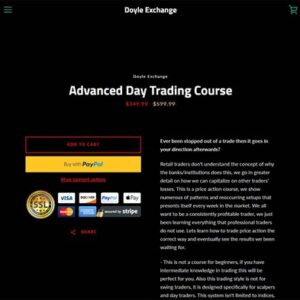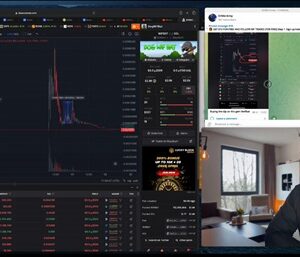Market Fluidity University – Unlearn and Relearn
$35.00
- Delivery: You Will Receive A Receipt With Download Link Through Email.
- If you need more proof ofcourse, feel free to chat with me!

Description
Table of Contents
ToggleMarket Fluidity University Mastering the Art of Trading through Candle Movements
In today’s fast-paced trading environment, understanding market dynamics is essential. Welcome to the Market Fluidity University, a comprehensive educational platform designed for aspiring traders eager to master the art of trading through candle movements. This university emphasizes the importance of interpreting candlestick patterns, enabling traders to make informed decisions that can lead to successful trading outcomes.
Introduction to Market Fluidity
The concept of market fluidity encapsulates the essence of trading in an ever-evolving financial landscape. It refers to the ability to swiftly adapt to changing market conditions and trends, facilitating profitable trading opportunities. At Market Fluidity University, we understand that fluidity is not merely about quick trades; it’s about fostering a deep comprehension of market structures, price movements, and trader psychology.
Understanding Market Fluidity
Market fluidity is akin to water flowing in a stream, constantly shifting and adjusting to various elements in its path. In trading, this fluidity translates to the need for adaptability and responsiveness to market changes. As traders, we must recognize that markets are influenced by numerous factors ranging from geopolitical events to economic data releases. By honing our skills in analyzing these fluid dynamics, we can better position ourselves to take advantage of market movements.
Fluid markets present both challenges and opportunities. A trader who can interpret candlestick patterns effectively is at a significant advantage. Candlesticks provide visual representations of price movement over specified periods, revealing crucial information about buyer and seller sentiment. Ultimately, mastering the art of reading candlesticks equips traders with the tools necessary for making sound trading decisions.
The Importance of Candlestick Analysis
Candlestick analysis serves as one of the foundational pillars of technical trading. Each candlestick contains vital information about price action within a specific timeframe, showing us the open, close, high, and low of each period. This data allows traders to gauge market sentiment—whether bullish or bearish—and identify potential reversals and continuations in trends.
At Market Fluidity University, we place significant emphasis on the role of candlestick patterns in our trading strategies. By learning to recognize these patterns, traders can enhance their predictive capabilities, thus improving their overall trading performance. Patterns such as dojis, hammers, and engulfing candles can signal potential market shifts, guiding traders in their decision-making processes.
Overview of Learning Outcomes
As students progress through the curriculum at Market Fluidity University, they will gain a range of competencies that will empower their trading journeys. From understanding market fluidity and candlestick analysis to mastering trading psychology and risk management, the knowledge and skills acquired will lay the groundwork for achieving consistent success in trading.
Upon completion of the program, students will be equipped to craft personalized trading plans, interpret market signals effectively, and engage with a community of like-minded traders. Ultimately, our goal is to provide learners with the confidence and expertise needed to navigate the complexities of the trading world successfully.
Unlearn and Relearn
To embark on a successful trading journey, traders often need to challenge and unlearn preconceived notions that may have held them back. Market Fluidity University recognizes that embracing new strategies is essential for growth, which is why the theme of unlearning and relearning is woven throughout the curriculum.
Identifying Misconceptions in Trading
Many traders carry misconceptions that can hinder their performance. For instance, the belief that trading is purely a numbers game can lead to an over-reliance on technical indicators without considering market context. This mindset can overshadow the importance of fundamental analysis, emotional intelligence, and market psychology.
Identifying and addressing these misconceptions is critical to developing a well-rounded trading approach. Market Fluidity University encourages students to conduct self-reflection, recognizing thought patterns that may need adjustment. By actively challenging outdated beliefs, traders can create a more adaptable mindset conducive to learning and growth.
Embracing New Strategies
The financial markets are dynamic, and strategies that once proved effective may no longer yield desired results. To thrive in this landscape, traders must remain open to evolving tactics and methodologies. At Market Fluidity University, we explore diverse trading techniques, encouraging students to experiment with strategies that resonate with their trading style.

Embracing new strategies involves staying informed about emerging market trends and technological advancements. Students learn how to incorporate innovative tools into their trading arsenal while adhering to the principles of discipline and patience. This flexibility enhances their chances of identifying lucrative trading opportunities.
Importance of a Growth Mindset
A growth mindset is central to success in trading. It involves the belief that skills and abilities can be developed through dedication and hard work. Instead of viewing failures as setbacks, traders are encouraged to see them as valuable learning experiences. Market Fluidity University fosters this mindset, creating an environment where students can cultivate resilience and adaptability.
By nurturing a growth mindset, traders develop the capacity to embrace challenges, seek feedback, and engage in continuous improvement. This perspective empowers them to push beyond comfort zones, leading to enhanced performance and increased confidence in their trading abilities.
Psychology in Trading
Trading is as much about mental fortitude as it is about technical skills. At Market Fluidity University, we emphasize the significance of psychology in trading, delving into the emotional aspects that can influence decision-making processes.
The Role of Emotions in Trading
Emotions play a pivotal role in trading outcomes. Fear, greed, excitement, and anxiety can cloud judgment, leading to impulsive decisions that deviate from well-structured trading plans. Understanding the impact of emotions is essential for developing effective coping mechanisms.
Market Fluidity University equips students with insights into emotional awareness and regulation techniques. By recognizing emotional triggers, traders can implement strategies to mitigate their effects. Techniques such as journaling and visualization exercises empower traders to maintain composure during volatile market conditions.
Developing a Trading Mentality
Cultivating a robust trading mentality is crucial for long-term success. This involves adopting disciplined habits, setting realistic expectations, and maintaining consistency. Market Fluidity University provides students with tools to foster a resilient trading mentality.
Students are encouraged to establish clear goals and define their trading philosophies. By aligning their actions with their values, traders can create a sense of purpose in their trading endeavors. Moreover, understanding the psychological barriers that arise during downturns enables traders to stay committed to their strategies.
Stress Management Techniques
The trading environment can be stressful, with rapid fluctuations and unexpected events. Therefore, effective stress management techniques are imperative. Market Fluidity University introduces students to a variety of strategies for managing stress and maintaining focus.
Mindfulness practices, breath control, and physical exercise can alleviate stress and improve overall well-being. Incorporating these techniques into daily routines promotes mental clarity, allowing traders to approach the markets with a calm and composed mindset.
Trade Management Fundamentals
Effective trade management is the backbone of successful trading. At Market Fluidity University, we delve into the fundamental aspects of trade management to equip students with the skills they need to navigate the challenges of the trading landscape.
Setting Up a Trading Plan
Creating a comprehensive trading plan is essential for guiding decision-making and enhancing overall performance. A well-structured trading plan outlines goals, strategies, risk tolerance, and criteria for entering and exiting trades.
Market Fluidity University emphasizes the importance of tailoring trading plans to individual preferences and risk appetites. By establishing clear guidelines, traders can reduce emotional interference and adhere to systematic approaches.
Risk Management Essentials
Risk management is a cornerstone of sustainable trading. At Market Fluidity University, students learn to assess risk accurately and employ strategies to safeguard their capital.
Key components of risk management include position sizing, stop-loss orders, and diversification. Understanding how to set appropriate risk thresholds ensures that traders can withstand market fluctuations without jeopardizing their overall portfolios.
Keeping Losses Under Control
Losses are an inevitable aspect of trading, but how traders respond to them can significantly impact their long-term success. At Market Fluidity University, we teach students how to keep losses under control through effective strategies.
Implementing stop-loss orders is one method for managing potential losses. Additionally, traders learn to adopt a positive mindset when faced with losses, viewing them as opportunities for growth rather than failures. Analyzing losing trades provides invaluable insights that can inform future decisions and improve overall performance.
Advanced Technical Concepts
As traders progress in their journey, exploring advanced technical concepts becomes essential for refining their skills. At Market Fluidity University, we dive into intricate technical analysis techniques that empower traders to make informed decisions.
Candlestick Patterns and Their Implications
Candlestick patterns hold significant implications for price action and trend direction. Recognizing and interpreting these patterns is crucial for anticipating potential market movements.
Traders learn to differentiate between bullish and bearish patterns, gaining insights into the psychology behind each formation. For example, a hammer pattern may indicate a potential reversal, signaling traders to consider entry points. Understanding the nuances of candlestick patterns enhances traders’ ability to spot opportunities and mitigate risks.
Analyzing Market Trends
Analyzing market trends is fundamental to successful trading. Market Fluidity University teaches students how to identify various types of trends, including uptrends, downtrends, and sideways movements.
Understanding the characteristics of each trend type enables traders to align their strategies with prevailing market conditions. By incorporating trend analysis into their trading philosophy, students can enhance their chances of executing successful trades.
Understanding Support and Resistance Levels
Support and resistance levels serve as critical reference points for traders. At Market Fluidity University, students learn to identify these levels through comprehensive analysis of price charts.
Support levels denote price points where buying interest tends to emerge, while resistance levels signify areas where selling pressure intensifies. Recognizing these levels allows traders to make more informed decisions regarding entry and exit points, ultimately improving their trading outcomes.
Adding Positions to Trades
Strategically adding positions to existing trades can amplify potential rewards while managing risk. Market Fluidity University explores the methodologies for recognizing trend opportunities and scaling in or out of trades.
Recognizing Trend Opportunities
Identifying favorable trend opportunities is crucial for optimizing trading performance. Traders learn to analyze price movements, patterns, and market sentiment to determine whether to enter new trades or add to existing positions.
By focusing on momentum and volume, students can evaluate the strength of trends and make informed decisions about scaling into trades. Recognizing key indicators that signal trend continuation empowers traders to capitalize on lucrative opportunities.
When to Scale In or Out of Trades
Knowing when to scale in or out of trades requires a nuanced understanding of market dynamics. Market Fluidity University guides students through the process of determining optimal entry and exit points based on market behavior.
Scaling in involves gradually increasing exposure to a winning trade, while scaling out entails taking partial profits as the trade progresses. These techniques allow traders to balance risk and reward, ensuring they benefit from favorable market movements.
Utilizing Stop-Loss Orders Effectively
Stop-loss orders serve as protective measures against adverse price movements. At Market Fluidity University, students learn how to implement stop-loss orders strategically, safeguarding their capital while allowing for potential gains.
By setting appropriate stop-loss levels based on market volatility and personal risk tolerance, traders can minimize losses without prematurely exiting trades. This disciplined approach enhances overall trade management and contributes to long-term success.
Learning from Losses
Embracing the learning experience that comes with losses is fundamental to becoming a skilled trader. At Market Fluidity University, we emphasize the importance of analyzing failures and adapting strategies accordingly.
Analyzing Trade Failures
Every loss holds valuable insights that can contribute to future success. Traders are encouraged to conduct thorough analyses of losing trades, identifying factors that led to unfavorable outcomes.
By examining the circumstances surrounding each loss—whether it was due to emotional decisions, miscalculations, or market conditions—traders can refine their strategies and avoid repeating mistakes. This practice fosters a culture of continuous improvement and accountability.
Adapting Strategies Post-Loss
Adaptability is key to thriving in the trading world. After experiencing a loss, traders must assess their strategies and consider adjustments based on the lessons learned.
Market Fluidity University provides students with frameworks for reevaluating their approaches after setbacks. Understanding that losses are part of the journey allows traders to remain resilient and open to experimentation, ultimately leading to improved performance over time.
Building Resilience in Trading
Resilience is a vital trait for traders facing the ups and downs of the financial markets. At Market Fluidity University, we encourage students to cultivate resilience through positive reinforcement and supportive practices.
Developing a strong support system among fellow traders fosters a sense of community and shared experiences. Engaging in discussions about challenges and triumphs creates an environment where traders can uplift one another, reinforcing the idea that persistence leads to success.
Back to the Basics
Regardless of experience level, revisiting the fundamentals of trading is essential. Market Fluidity University encourages students to connect with core principles that underpin successful trading practices.
Fundamental Principles of Forex Trading
Forex trading operates on principles that govern currency exchange rates and market dynamics. Market Fluidity University reinforces the importance of understanding these core principles, ranging from supply and demand to interest rate differentials.
Grasping the foundational concepts establishes a framework for interpreting market movements. By returning to the basics, traders can enhance their analytical skills and build a solid foundation for advanced strategies.
Key Indicators to Monitor
Monitoring key economic indicators is paramount for forex traders. Understanding how metrics such as GDP, unemployment rates, and inflation affect currency values informs trading decisions.
Market Fluidity University highlights the significance of tracking relevant news and data releases. By integrating this information into their trading strategies, students can gain a competitive edge and adjust their approaches in response to market developments.
Revisiting Essential Strategies
Periodically reassessing essential trading strategies is vital for ensuring their effectiveness. Market Fluidity University emphasizes the importance of evaluating strategies against current market conditions and personal goals.
Traders are encouraged to reflect on their successes and failures, adapting their strategies as necessary. This iterative approach fosters growth and keeps traders aligned with their objectives.
The Signs 2.0
Recognizing market signals is crucial for timely and effective trading. At Market Fluidity University, we delve into the prerequisites for identifying and acting upon key market signals.
Prerequisites for Effective Trading
Effective trading requires foundational knowledge, analytical skills, and emotional discipline. Market Fluidity University instills these prerequisites in students, empowering them to navigate complexities confidently.
By building a strong base, traders can enhance their ability to interpret market signals accurately. This preparation fosters a proactive mindset, allowing students to seize opportunities as they arise.
Identifying Market Signals
Market signals can manifest in various forms, including candlestick patterns, technical indicators, and economic news. Successful traders learn to synthesize this information to make informed decisions.
At Market Fluidity University, students receive training on how to distinguish between noise and meaningful signals. By honing their analytical skills, traders can develop a keen sense of when to enter or exit positions based on real-time data.
Knowing When to Act
Timing is everything in trading. Understanding when to act upon market signals is a skill that can be developed through practice and training. Market Fluidity University emphasizes the importance of timing in maximizing potential profits.
Through simulated trading sessions and live scenarios, students learn to assess market conditions and execute trades at opportune moments. This experiential learning enhances their confidence and reduces hesitation when faced with real-world trading challenges.
Simulations for Practical Learning
Simulating real-world trading scenarios is an invaluable component of education at Market Fluidity University. Practical learning through simulations bridges the gap between theory and practice, allowing students to hone their skills in a controlled environment.
The Value of Realistic Simulations
Realistic simulations provide traders with hands-on experience without the financial risks associated with live trading. Students can practice executing trades, testing strategies, and navigating market volatility in a safe space.
These simulations facilitate experiential learning, enabling traders to reinforce their knowledge and develop intuition. By engaging in realistic scenarios, students gain confidence in their decision-making abilities.
Developing Intuition Through Practice
Intuition plays a vital role in trading success. Through repeated exposure to simulated trading environments, students develop the instinct to recognize patterns and respond promptly to market changes.
Market Fluidity University encourages students to embrace trial and error during simulations. This process of exploration helps them refine their instincts, ultimately translating into more informed decisions in live trading situations.
Feedback Mechanism in Simulations
Feedback is a crucial component of the learning process. Market Fluidity University integrates structured feedback mechanisms into simulated trading sessions, providing students with insights into their performance.
Traders receive constructive critiques on their decision-making, strategy execution, and risk management. This feedback loop fosters continuous improvement, allowing students to make adjustments and enhance their trading proficiency.
Community Engagement via Slack
Engagement within a trading community amplifies the learning experience. At Market Fluidity University, students benefit from active participation in a dedicated Slack community that fosters connection and collaboration.
Benefits of Being Part of a Trading Community
Being part of a trading community offers numerous advantages, including networking opportunities, access to diverse perspectives, and emotional support. Market Fluidity University facilitates connections between traders who share similar goals and aspirations.
Through community engagement, students can exchange ideas, share insights, and learn from one another’s experiences. This collaborative environment enriches the educational experience and encourages mutual growth.
Channels for Different Trading Sessions
Market Fluidity University’s Slack community includes session-specific channels for different trading sessions, such as Asian, London, and NY. Traders can engage in focused discussions tailored to their preferred trading times.
These channels foster real-time communication and allow traders to share trade ideas, market analyses, and strategies. By collaborating with peers during specific trading hours, students gain insights into diverse trading approaches.
Accessing Expert Insights and Feedback
Direct access to experienced traders and mentors is a hallmark of Market Fluidity University. Students can seek guidance, ask questions, and receive feedback on their trading activities through the Slack community.
This open line of communication facilitates knowledge sharing and encourages students to leverage the expertise of seasoned traders. Engaging with mentors enhances students’ understanding of complex concepts, contributing to their growth as traders.
Live Trading Sessions
Live trading sessions provide students with the opportunity to observe and participate in real-time trading scenarios. At Market Fluidity University, these sessions are conducted via Zoom, offering interactive and dynamic learning experiences.
The Structure of Live Zoom Sessions
Live Zoom sessions encompass a structured format where traders can engage with instructors and fellow participants. These sessions typically consist of market analyses, trade setups, and discussions on current trends.
Students are encouraged to ask questions, share their observations, and participate actively in the discussions. This collaborative atmosphere creates a vibrant learning environment where traders can benefit from diverse perspectives.
Learning from Real-Time Trading Scenarios
Observation is a powerful tool in the learning process. During live trading sessions, students witness firsthand how experienced traders analyze market conditions, make decisions, and manage trades.
These real-time scenarios provide practical insights into the intricacies of trading. By observing the thought processes of seasoned professionals, students can extrapolate valuable lessons that enhance their own trading abilities.
Networking with Fellow Traders
Live trading sessions also offer networking opportunities with like-minded individuals. Connecting with fellow traders fosters a sense of camaraderie and support, creating lasting relationships within the trading community.
By sharing experiences and insights, traders can motivate each other to stay disciplined and focused on their goals. Networking enhances the overall learning experience and opens doors for collaboration and partnership.
Resources for Continued Learning
Continuous learning is integral to the journey of a successful trader. Market Fluidity University provides an array of resources to support ongoing educational opportunities for students.
Access to Webinars and Training Materials
Students enjoy free access to past and future webinars offered by Market Fluidity University. These webinars cover a wide range of topics, from technical analysis to risk management strategies.
Additionally, students can access training materials and recorded sessions to reinforce their understanding of key concepts. This wealth of resources empowers traders to stay informed and continuously expand their knowledge base.
Downloadable PDFs for Reference
Comprehensive PDFs containing valuable insights and strategies are available for download at Market Fluidity University. These reference materials serve as handy guides for traders seeking to revisit key principles and techniques.
Students can refer to these documents when implementing trading strategies or preparing for market analysis. Having easy access to essential information supports traders in their daily activities.
Ongoing Educational Opportunities
Education does not end upon completion of a course. Market Fluidity University emphasizes lifelong learning, providing students with opportunities to further their knowledge even after graduation.
Ongoing workshops, advanced courses, and guest speaker events ensure that traders remain engaged and informed about emerging trends and developments. This commitment to continuous education fosters a culture of growth and innovation within the trading community.
Disciplinary Practices in Trading
Discipline is a defining characteristic of successful traders. At Market Fluidity University, we instill the importance of cultivating discipline as an integral part of the trading journey.
Cultivating Patience in Trading
Patience is a virtue in trading, especially when waiting for ideal entry and exit points. Effective traders understand that rushing into trades can lead to costly mistakes.
Market Fluidity University emphasizes mindfulness and reflection, encouraging students to take measured approaches to trading. Developing patience allows traders to wait for confirmations before executing trades, ultimately enhancing their success rates.
Importance of Discipline Over Time
Discipline extends beyond individual trades; it shapes a trader’s entire approach to the markets. Consistency in following established trading plans and strategies is essential for long-term success.
Market Fluidity University fosters a culture of accountability, encouraging students to adhere to their trading rules and guidelines. This commitment to discipline builds trust in one’s strategies and decision-making abilities.
Daily Routines for Successful Traders
Establishing daily routines can significantly impact a trader’s performance. Market Fluidity University provides guidance on creating structured schedules that prioritize self-care, education, and skill development.
Incorporating practices such as market analysis, journaling, and reflection into daily routines sets a positive tone for trading activities. By dedicating time to self-improvement, traders can cultivate the habits necessary for success.
Advanced Strategy Development
Developing advanced trading strategies requires a combination of analytical skills, market knowledge, and creativity. At Market Fluidity University, students are empowered to create personalized strategies that align with their trading objectives.
Creating Personalized Trading Strategies
Personalized trading strategies are rooted in individual preferences and strengths. Market Fluidity University guides students through the process of crafting unique approaches that reflect their risk tolerance, time commitment, and market understanding.
By integrating various technical and fundamental analysis techniques, traders can develop comprehensive strategies that cater to their unique trading styles. This customization enhances traders’ confidence and effectiveness in executing trades.
Combining Multiple Analytic Approaches
Successful traders often leverage multiple analytic approaches to enhance their decision-making. Market Fluidity University emphasizes the value of combining technical analysis with fundamental insights.
Integrating different methodologies allows traders to gain a holistic view of the market. By synthesizing insights from various sources, students can identify compelling trade setups and make more informed decisions.
Testing and Refining Your Strategy
Testing and refining strategies is a fundamental aspect of the trading process. Market Fluidity University encourages students to engage in backtesting and forward-testing to validate their approaches before applying them in live markets.
Through simulation and real-time analysis, traders can assess the effectiveness of their strategies and make necessary adjustments. This iterative process fosters a culture of continuous improvement and enhances overall trading performance.
Risk Management Techniques
Effective risk management is crucial for protecting capital and sustaining long-term profitability. At Market Fluidity University, students learn comprehensive risk management techniques to safeguard their trading activities.
Comprehensive Risk Assessments
Conducting comprehensive risk assessments is the foundation of sound trading practices. Market Fluidity University provides students with tools to evaluate potential risks associated with individual trades and overall portfolios.
By analyzing factors such as market volatility, position sizes, and correlation between assets, traders can make informed decisions that minimize potential losses. This proactive approach enhances overall risk management.
Leveraging Risk-Reward Ratios
Understanding risk-reward ratios is essential for assessing the viability of trades. Market Fluidity University teaches students how to calculate and leverage these ratios to ensure that potential rewards outweigh associated risks.
By maintaining favorable risk-reward ratios, traders can increase their chances of profitability over time. This strategic focus empowers students to make confident trading decisions that align with their goals.
Adjusting to Market Volatility
Market volatility can significantly impact trading outcomes. At Market Fluidity University, students learn to adjust their strategies based on changing market conditions.
By staying attuned to volatility and liquidity measures, traders can adapt their approaches to mitigate risks and capitalize on opportunities. This flexibility is essential for navigating turbulent market environments.
Trading Plans Revisited
Trading plans are living documents that require periodic evaluations and adjustments. Market Fluidity University emphasizes the importance of revisiting trading plans to ensure they remain relevant and effective.
Structuring an Effective Trading Plan
An effective trading plan serves as a roadmap for traders, outlining their goals, strategies, and risk management protocols. At Market Fluidity University, students learn how to structure their trading plans for maximum effectiveness.
By incorporating clear objectives, entry and exit criteria, and risk parameters, traders can create comprehensive plans that guide their decision-making processes. A well-structured trading plan enhances discipline and accountability.
Incorporating Flexibility in Your Approach
While having a structured plan is essential, flexibility is equally important. Market Fluidity University encourages students to incorporate adaptability into their trading plans, allowing for adjustments based on evolving market conditions.
Flexibility enables traders to respond to unforeseen events and capitalize on emerging opportunities. Striking a balance between structure and adaptability fosters resilience in the face of uncertainty.
Evaluating Success Metrics
Regularly evaluating success metrics provides valuable insights into trading performance. Market Fluidity University teaches students how to track key performance indicators (KPIs) such as win rates, average returns, and risk-adjusted metrics.
By analyzing these metrics, traders can identify strengths and weaknesses in their strategies. Continuous evaluation allows for informed decision-making and targeted improvements in trading practices.
The Impact of Economic News on Trading
Economic news releases play a pivotal role in shaping market sentiment and price movements. Understanding how to navigate these events is essential for traders aiming to capitalize on volatility.
How Economic Indicators Affect Markets
Economic indicators, such as employment reports, inflation data, and central bank announcements, have profound impacts on currency values and market dynamics. Market Fluidity University helps students comprehend the implications of these indicators on trading strategies.
By closely monitoring economic news, traders can anticipate potential market reactions and adjust their positions accordingly. Staying informed about upcoming economic events enhances traders’ ability to make timely and informed decisions.
Timing Your Trades Around News Releases
Timing is critical when trading around news releases. Market Fluidity University emphasizes the importance of developing strategies for trading during high-impact news events.
Traders learn to assess the potential volatility associated with news releases, determining whether to hold positions or avoid trading altogether. This strategic approach ensures that traders can navigate market fluctuations effectively.
Analyzing Historical Data for Future Predictions
Historical data analysis provides valuable insights into how markets have reacted to past economic news releases. Market Fluidity University teaches students how to analyze historical patterns to inform future predictions.
By studying previous price movements following news events, traders can identify trends and formulate strategies that align with anticipated market behavior. This analytical approach enhances traders’ forecasting capabilities.
Conclusion Becoming a Skilled Trader
Embarking on the journey to become a skilled trader requires dedication, education, and continuous improvement. At Market Fluidity University, we strive to equip students with the knowledge and skills needed to navigate the complexities of the financial markets.
The Journey of Continuous Improvement
Trading is not a destination but a journey of continuous improvement. As students progress through the curriculum, they are encouraged to embrace learning opportunities that contribute to their growth as traders.
By prioritizing education and staying open to new ideas, traders can refine their skills over time. The pursuit of excellence is a lifelong endeavor that ultimately leads to greater success in trading.
Transforming Knowledge into Profitable Trades
Knowledge alone is not enough to guarantee success; it must be translated into actionable strategies. Market Fluidity University emphasizes the importance of applying learned concepts to real-world trading situations.
By consistently practicing and implementing strategies, traders can translate their knowledge into profitable trades. This transformation relies on discipline, patience, and the willingness to adapt to changing market conditions.
Emphasizing Lifelong Learning in Trading
Finally, we underscore the significance of lifelong learning in trading. The financial markets are constantly evolving, and traders must remain vigilant and informed to stay ahead of the curve.
Market Fluidity University fosters a culture of curiosity and exploration, encouraging students to seek out new knowledge and perspectives. By committing to ongoing learning, traders can build resilience and adaptability, positioning themselves for sustained success in the dynamic trading landscape.
Sales Page: _https://market-fluidity.teachable.com/p/market-fluidity
Related products
-
Sale!

Doyle Exchange Advanced Day Trading Course
$349.00Original price was: $349.00.$34.90Current price is: $34.90. -
Sale!

Ninjatrader Automated Trading Systems – NinjaTrader 8 Algo Bot – Trading123
$3,595.00Original price was: $3,595.00.$35.00Current price is: $35.00. -

Trader Dante – Edges for Ledges 2024
$32.00 -
Sale!

How To Find New Crypto Projects – Dr Niki
$117.00Original price was: $117.00.$15.00Current price is: $15.00.
Reviews
There are no reviews yet.